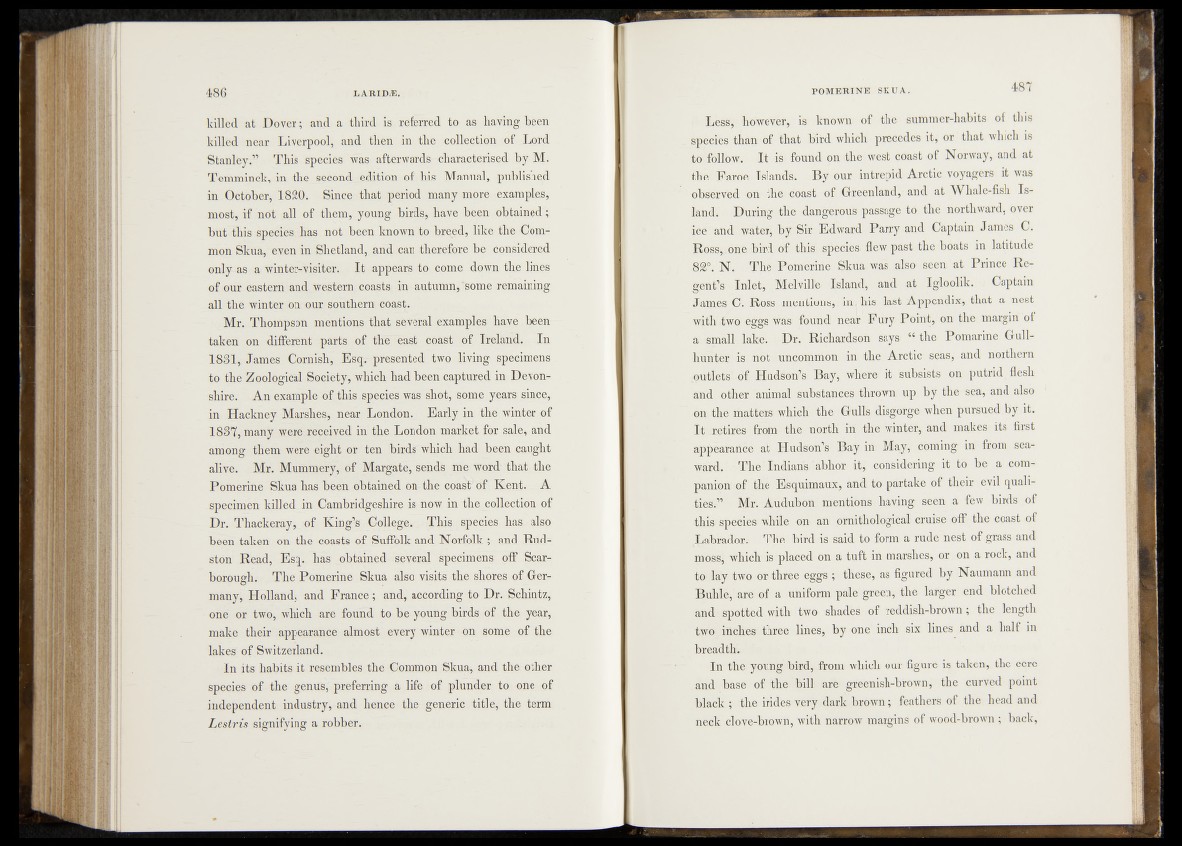
killed at Dover; and a third is referred to as having been
killed near Liverpool, and then in the collection of Lord
Stanley.’’ This species was afterwards^ characterised by M.
Temminck, in the second edition of his Manual, published
in October, 1820. Since that period many more examples»
most, if not all of them, young birds, have been obtained?*;
but this species..has. not been known to brqgd, like the Common
Skua, even in Shetland, and can therefore be considered
only as a winter-visiter. I t appears to come down the lines
of our eastern and western, coasts? in autumn,‘some remaining
all the winter on our southern coast.
Mr. Thompson mentions that several examples haye been
taken on different parts of thtTeast coast of Ireland. -In
1881, James Cornish, Esqr presented. two living specimens
to the Zoological Society, which had.been captured in Devonshire.
An example of this Species was shot, some years since,
in Hackney Marshes, near London. Early in the winter of
1837, many were received in the London market for sale, and
among them were eight or ten birds' which had been caught
alive. .Mr. Mummery, of Margate, sends, me word' that. the
Pomerine Skua has been obtained on the coast* 6f Kent. ... A
specimen killed , in Cambridgeshire is now in the_collection pf
Dr. Thackeray,. of Kin^s College,| This species has-also
been taken on the coasts of Suffolk and Norfolk; and Rud-
ston Read, Esq. has obtained- several specimens off Scarborough.
The Pomerine Skua also visits the shores of Germany,
Holland, and France; and, according to Dr. Schintz,
one or two, which are found to be young birds of the year,
make their appearance almost ' every winter on some of the
lakes of Switzerland.
In its habits it resembles the Comihon Skua, and the other
species of the genUs, preferring a life of plunder to one of
independent industry, and hence the generic title, the term
Lesiris signifying a robber.
! Less, however, is known of the summer-habits of this
species than of that bird which precedes it," or that which is
to| pM!bffr. I t is found on dhe west coast of Norway, and at
the Faroe Islands By our intrepid Arctic voyagers it was
observed on the?coastr-f@f Greenland,: and at AVhal e-fish Island.
During the dangerous passage to the northward, over
ice and water* by*’Sir Edward Parry and Captain James C.
Rossvpne ■bfed-of^tM/? species? flew past the boats in latitude
%2°f*N. The Pomerhfe Skua was also* seen at Prince Regent’s
Inlet, Melvilfe- 'Island.* v‘ and at Igloolik. . Captain
J am ^ C. Russ' mentionsSn. his last Appendix, that a nest
with /two eggs was found near Fury Point, on the margin of
a small lake.-^VDr. Richardson says “ the Pomarine Gull-
huntPt1 is 1 not 'uncomnion^in the. Arctic' seas, and northern
uutlets’b f Hudson’s B a ^ f where it subsists on putrid flesh
and other Tanimal substances thrown up b^ the sea, and also
on the matters which ^the Gulls disgorge when pursued by it.
Itexetires from -fhiljhorth in the winter, and makes1 its first
appearaiiceVat Hudson’s Bay in? May, .coming in from seaward.
The'Indians'abhor itf ^ ^ id e r in g it to be a companion'
of' the Esquimaux? and to partake of their evil quali-
i e S ^ ^ ’ Mr. Audubon mentions shaving seen a few birds of
-this species while on an ornithological cruise off the coast of
Labrador.^ The bird is -said to form a rude iiest of grass and
moss, which is placed on a tuft in marshes, or on a rock, and
to lay two ox three eggs ; these, as figured by Naumann and
Buhle, are of a uniform pale green, the larger end blotched
and spotted with two shades’ of reddish-brown; the length
two: inches three lines*; by one inch six lines and a half in
breadth'..
In the young bird, from which our figure is taken, the cere
and [base of the bill are greenish-brown, the curved point
black ; the irides very dark brown; feathers of the head and
neck clove-brown, with narrow margins of wood-brown ; back,